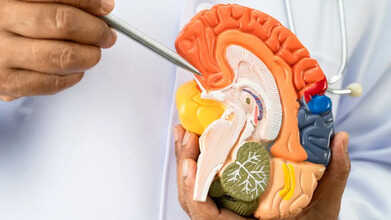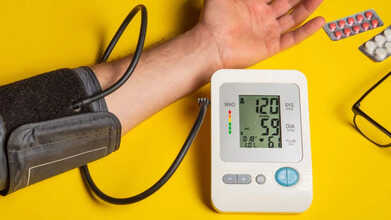- Health Conditions A-Z
- Health & Wellness
- Nutrition
- Fitness
- Health News
- Ayurveda
- Videos
- Medicine A-Z
- Parenting
- Web Stories
Strokes Are No Longer An Old Age Disease: Make These Lifestyle Changes Now

Despite all advancements in the medical space, stroke continues to be a serious—and often silent—condition that affects people across the age spectrum, although various groups are at differing stages of risk.
“Stroke would mean a vascular insult to the brain, where a blockage in one of its arteries prohibits the vital flow of blood, ” explains a neuroscience expert. She adds that owing to the tendency of the brain cells to die faster than cells of other body parts, strokes are required to be considered as an alarming event that can potentially threaten one’s life.
Strokes Are No Longer Just a Senior Issue
As per the latest numerics, one in four people will encounter a stroke in the course of their life. with a stroke taking place worldwide every three seconds. While strokes were predominantly viewed as a disease of senior citizens priorly, recent data has indicated that 63% of strokes now occur in individuals under the age of 70, with 10–15% affecting adults between 18 and 50.
For older adults, the main root is commonly the stiffening of arteries because of atherosclerosis —a condition where cholesterol-rich plaque builds up which blocks the blood flow. However, experts have observed that younger people, which implies those between the ages of 18 and 45, are also prone to it, because of common risk factors like diabetes, high blood pressure, high cholesterol and smoking.
Alarming Statistics: Stroke Incidence in Younger Adults
Different triggers for stroke in younger demographics would involve explicit cardiovascular and hematologic conditions, diseases, provocative ailments, certain drugs, and at times, hereditary qualities. Alarmingly, in 25-35% of young stroke casualties, the specific reason remains uncertain.
A prominent medical expert highlights the trouble of higher chances of stroke in India. "Regardless of it being the second most common reason for death in India, stroke remains ineffectively understood and deficiently attended to," she comments.
Importance of Prevention: Lifestyle Changes for Stroke Risk Reduction
Stroke and cardiovascular illnesses frequently tend to share normal factors, like hypertension, dyslipidemia (elevated cholesterol), diabetes, smoking, and weight—all lifestyle-related issues that are gradually becoming mainstream in India. Normally, a stroke emerges all of a sudden: either from an impeded vein that blocks brain blood supply or from a vessel break that results in bleeding and expanded cerebrum pressure.
Normal side effects involve weakness, slurred speech, visual inconvenience, loss of motion, or, in serious instances, death. The expert also underscores that the outcomes of a stroke vary across patients, essentially influencing the lives of family members. She also advocates for a proactive methodology in stroke prevention, including changes in lifestyle—like a fixed eating routine, regular exercise, and control over blood pressure.
As far as newborn children are concerned, strokes might occur even before their birth or within the initial 28 days, through a condition known as perinatal stroke. “Roughly 80-85% of strokes, regardless of age, are ischemic—meaning they result from a blood clot that blocks the stream of blood to the brain," the expert says.
In perinatal cases, blood vessel ischemic areas of dead tissue represent most strokes, however they are because of cerebrum haemorrhages or blood clusters.
Certain genetic problems—for instance, sickle cell sickliness—are connected to a heightened risk of stroke in younger individuals. As the expert explains, normal stroke side effects— including facial drooping, weakness on one side of the body, and speech loss—are comparable across age groups.
Nonetheless, youngsters may likewise encounter extra side effects like dizziness, slurred speech, loss of sight, or trouble moving around. Awareness gaps imply that strokes in younger people might be misjudged, thus hindering treatment.
Alzheimer’s In Women: Why Women Are At Higher Risk And How To Detect It Early

Image credits: Canva
Did you know that among the 6.2 million Americans aged 65 and older living with Alzheimer’s disease, nearly two-thirds are women? This means women are almost twice as likely as men to develop the condition. While longer life expectancy partly explains the difference, research shows that hormonal changes after menopause, genetic factors, and certain lifestyle patterns also increase risk.
As a result, understanding the early warning signs and taking preventive steps is especially important for women, who face a higher likelihood of developing Alzheimer’s as they age.
Women and Alzheimer’s: Why The Risk Is Higher
Dr. Brij Lal Choudhary, Consultant Neurologist at Manipal Hospital, Jaipur, points out that Alzheimer’s is often seen as a condition of old age, but women are disproportionately affected. Nearly two-thirds of Alzheimer’s patients are women, making it almost twice as common in women compared to men. While longer life expectancy plays a role, other factors, such as hormonal changes after menopause, genetic predisposition, and lifestyle patterns also increase risk.
Early Signs of Alzheimer’s Women Should Watch
Recognising early symptoms is key, as catching them in time can make a significant difference. Common signs include:Memory loss: Forgetting recent events, appointments, or familiar names, with lapses gradually worsening.
ALSO READ: Chronic Insomnia Could Increase The Risk Of Dementia By 40%: Study
- Difficulty managing tasks or problem-solving: Struggling with daily responsibilities, finances, or planning may indicate cognitive changes.
- Confusion: Feeling disoriented over simple or familiar activities.
- Mood or personality changes: Sudden anxiety, frequent irritability, or withdrawing from social life.
- Language difficulties: Trouble finding the right words or expressing thoughts clearly.
Increased Risk of Alzheimer's in WomenStudies consistently show that women are at a higher risk of developing Alzheimer's disease compared to men. For instance, a Swedish study involving 16,926 participants found that, starting around age 80, women were more likely to be diagnosed with Alzheimer's than men of the same age. Similarly, research in Taiwan indicated that over a seven-year period, women had a higher likelihood of developing Alzheimer's compared to men. A European meta-analysis revealed that approximately 13 women out of 1,000 developed Alzheimer's each year, compared to only seven men, as per Harvard Health Publishing.
ALSO READ: CDC Vaccine Panel Updates COVID-19 Guidelines: What You Need To Know
While the longer life expectancy of women contributes to this disparity, it doesn't fully explain the difference. Even among individuals of the same age, women are more likely to be diagnosed with Alzheimer's than men. This suggests that factors beyond longevity, such as hormonal changes, genetic predispositions, and immune system differences, may play significant roles in the increased risk for women.
How to Reduce Risk and Protect Cognitive HealthAlthough Alzheimer’s cannot be reversed, several steps can help lower risk and support brain health:
- Regular cognitive screenings to monitor changes over time.
- Mental stimulation through reading, puzzles, or learning new skills.
- Physical exercise to improve blood flow and overall health.
- Managing blood pressure and blood sugar to reduce vascular-related risks.
World Alzheimer’s Day 2025: 5 Early Warning Signs of Alzheimer’s Experts Say You Must Know

Credits: Canva
We all experience occasional forgetfulness or feel a bit scatterbrained from time to time, often attributing it to stress, a busy lifestyle, or simply getting older. However, repeated lapses in memory, confusion, or difficulty performing everyday tasks can sometimes signal the early stages of Alzheimer’s or other forms of dementia. Recognising these warning signs early is crucial, as timely awareness and intervention can help manage the condition more effectively and improve quality of life.
As we observe World Alzheimer’s Day 2025, it’s the perfect moment to learn about Alzheimer’s, understand its early indicators, and know what experts recommend paying attention to.
What Is Alzheimer’s?
Alzheimer’s disease is the most common form of dementia, a progressive brain disorder that gradually declines memory, thinking, and reasoning skills. It affects cognitive functioning and daily behaviours to such an extent that simple tasks, like eating, dressing, or walking can become challenging over time.ALSO READ: Chronic Insomnia Could Increase The Risk Of Dementia By 40%: Study
For most people, symptoms first appear in their mid-60s, according to the National Institute on Aging. Current estimates indicate that over 6 million Americans aged 65 and older may be living with Alzheimer’s. Age remains the greatest known risk factor, and with the population aging, the number of cases is expected to rise.
Stages of Alzheimer’sAlzheimer’s disease progresses gradually, with symptoms worsening over time. It is generally divided into three stages: early (mild), middle (moderate), and late (severe). In the early stage, memory lapses and confusion begin to interfere with daily life. During the middle stage, challenges with language, reasoning, and daily activities become more pronounced. In the late stage, individuals may lose the ability to communicate, require full-time care, and become highly dependent on others. Understanding the stages helps families and caregivers plan support and interventions more effectively.
Alzheimer’s vs Dementia
While Alzheimer’s is the most common cause of dementia, the two terms are not interchangeable. Dementia is a broad term describing a decline in cognitive function severe enough to interfere with daily life. Alzheimer’s specifically refers to a progressive brain disease marked by amyloid plaques and tau tangles, leading to memory loss and impaired thinking. Other types of dementia include vascular dementia, Lewy body dementia, and frontotemporal dementia, each with distinct causes and symptoms. Knowing the difference is essential for accurate diagnosis and treatment planning.Early Warning Signs of Alzheimer’s
Recognising the early warning signs of Alzheimer’s can help with timely diagnosis and care. Dr. Prajwal Rao, DM Neurology, Professor and Head of the Department of Neurology at Dr. D. Y Patil Medical College, Hospital and Research Center, Pimpri, Pune, explains:- Persistent Memory Loss: Forgetting recent conversations, events, or important dates more often than usual, affecting daily life.
- Difficulty in Planning or Problem-Solving: Challenges with tasks like handling finances, following recipes, or keeping track of everyday responsibilities.
- Impairment of Spatial Memory: Forgetting familiar routes or even one’s way back home.
- Changes in Mood or Personality: Increased irritability, withdrawal from social activities, or unexpected anxiety and depression.
Blood Pressure Monitoring: How Often Should Patients With Controlled Hypertension Check Their Readings

Credits: Canva
Blood pressure monitoring plays a key role in managing hypertension. For patients whose numbers are well controlled through lifestyle changes or medication, the question often arises: how often should they be checking at home? While regular monitoring helps track progress and detect changes early, checking too frequently can increase stress or lead to unnecessary worry. On the other hand, checking too infrequently may delay important adjustments in treatment. Below, we take a look at how much frequency is important to check your blood pressure.
Home Blood Pressure Monitoring: How Often To Track Your Readings
When you have controlled hypertension, checking your readings at home with a validated monitor is important but doing it properly matters just as much. The CDC and American Heart Association recommend measuring at the same times each day, usually once in the morning and once in the evening. Take at least two readings, spaced 1-2 minutes apart, then average them.
Avoid caffeine, smoking, or exercise in the 30 minutes before taking a reading. Sit quietly for five minutes beforehand, keep your back supported, feet flat on the floor, arm at heart level, cuff on bare skin, and don’t talk during the measurement.
ALSO READ: American Heart Association Updates Hypertension Guidelines: Here’s What To Know
How many times per week? For people with stable, well-controlled blood pressure, checking 3 to 4 times per week may be sufficient. If just starting home monitoring or adjusting treatment, doctors may ask for readings over a week (3-7 days) to get a clear picture.
What is Ambulatory Blood Pressure Monitoring?
Ambulatory blood pressure monitoring (ABPM) is a method doctors use to track and understand high blood pressure over an entire day. Hypertension is diagnosed when the upper reading (systolic) is 130 mmHg or higher, or the lower reading (diastolic) is 80 mmHg or higher.
Unlike the usual check-up at a clinic, where a doctor measures your blood pressure once or twice with a cuff, ABPM gives a more complete picture. For this test, you wear a cuff on your arm that’s connected to a small device strapped to your waist or shoulder. The device automatically takes your blood pressure at regular intervals, every 15 to 30 minutes during the day and about once an hour at night, while you carry on with your normal activities, including sleep.
By the end of 24 hours, your doctor has dozens of readings instead of just one or two. This allows them to see your average blood pressure, how it changes throughout the day and night, and whether there are any unusual patterns. The device also records your heart rate, which adds more detail to the overall assessment.
Why Monitoring Matters Even When Blood Pressure Is Controlled?
Even if your blood pressure is well-controlled with medication or lifestyle changes, regular monitoring remains essential. Blood pressure can fluctuate due to stress, illness, sleep patterns, diet, or physical activity. Some patients may experience ‘masked hypertension,’ where readings appear normal in a clinic but are elevated at home, or ‘white coat hypertension,’ where anxiety in a medical setting temporarily raises readings.ALSO READ: H3N2 Flu Wave Hits Delhi: Paracetamol and Dolo Failing, Expert Reveals What to Take Instead
Tracking your blood pressure helps detect these patterns early, allowing timely adjustments in treatment and preventing long-term complications such as heart attack, stroke, or kidney damage. According to the American Heart Association, even small, consistent changes in readings over time can provide critical insights for maintaining cardiovascular health.
© 2024 Bennett, Coleman & Company Limited

